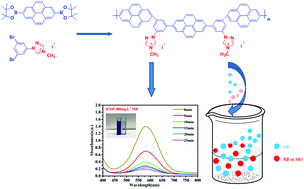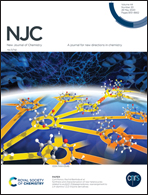An ionic covalent organic polymer toward highly selective removal of anionic organic dyes in aqueous solution†
Abstract
Owing to the well-defined porous structure and unique charge characteristics, ionic covalent organic polymers (ICOPs) are promising for gas capture, storage, drug delivery, adsorption and separation. Herein, we report a new ICOP that was synthesized via a simple Suzuki coupling reaction by introducing a monomer of 1-(3,5-dibromo-phenyl)-4-methyl-1H-[1,2,4]triazole-4-iodo iodide ionic liquid into a polymer framework. The as-prepared ICOP exhibited high adsorption capacity to methyl blue (MB) in aqueous solution because of the ion exchange of the ICOP with anionic dyes in aqueous solution. The adsorption equilibrium of the ICOP to MB with a concentration of 400 mg L−1 can be achieved within 20 min, which is much faster than that of non-ionic COPs. Moreover, the ICOP exhibits high stability with a removal rate of above 85% for MB after 10 consecutive cycles. It is also demonstrated that the ICOP is efficient for the selective adsorption of mixed dyes of MB with rhodamine B (RB) or methyl orange (MO) in aqueous solution. This work bodes well for the rational design of ICOPs to real-life applications in sewage treatment.



 Please wait while we load your content...
Please wait while we load your content...